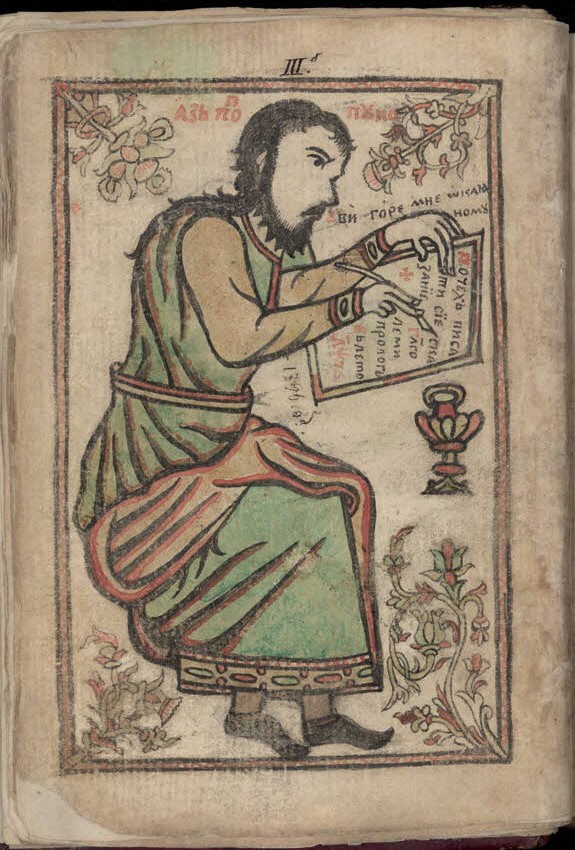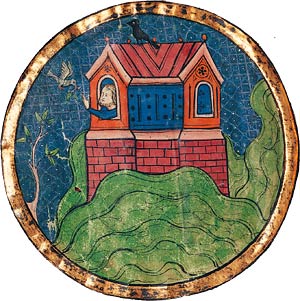|
Damaskins
Damaskin ( bg, Дамаскин) is a chronicle of church-liturgical books. Later, the damaskins became church collections with teaching words and lives. They appeared at the end of the 16th century in the western Bulgarian lands and existed until the middle of the 19th century. For the most part, the damaskins were written in a simple, accessible language for ordinary people. Typically, ''damask'' is a type of decoration on a metal or leather handicraft whose etymology originates in the city of Damascus. The name "damaskin" comes from the name of the first author of such a book - the Greek writer of the 16th century Damaskinos Stouditis, whose work "Thesauros" (Θησαυρός; 1558) contains 36 lives and teachings (printed in Venice). It was first translated into Bulgarian by Bishop Gregory Prilepski in the Holy Trinity skete at the Great Lavra Monastery in Athos. The first damaskins included only translations of Damaskinos Stouditis' works, and later, after the middle of ... [...More Info...] [...Related Items...] OR: [Wikipedia] [Google] [Baidu] |
Damaskinos Stouditis
Damaskinos Stouditis ( el, Δαμασκηνός Στουδίτης; Latin: Damascenus Studites) was a high-ranking Greek ecclesiastic and writer in the sixteenth century. Born in Thessaloniki around 1500, he became a monk in Constantinople, where he was a student of Thomas (Theophanes) Eleavoulkos Notaras at the Patriarchal Academy. In 1564 he was appointed Bishop of Lete and Rendina. In 1574 he was promoted to Metropolitan of Nafpaktos and Arta, and later became Patriarchal Exarch of Aitolia. He died in 1577. Sometime before 1558, when he was still a subdeacon (ὑποδιάκονος), Damaskinos composed his most famous and popular work, the ''Thesauros'' (Θησαυρός), a compendium of 36 sermons devoted to passages of the Bible. Written in contemporary vernacular Greek, this work reveals Damaskinos’ wide knowledge of scriptural, patristic, historical and philosophical literature. Since its ''editio princeps'' in Venice in 1568, the ''Thesauros'' has been published ... [...More Info...] [...Related Items...] OR: [Wikipedia] [Google] [Baidu] |
Miscellany Of Priest Puncho 1
A miscellany is a collection of various pieces of writing by different authors. Meaning a mixture, medley, or assortment, a miscellany can include pieces on many subjects and in a variety of different forms. In contrast to anthologies, whose aim is to give a ''selective'' and ''canonical'' view of literature, miscellanies were produced for the entertainment of a contemporary audience and so instead emphasise ''collectiveness'' and ''popularity''. Laura Mandell and Rita Raley state: Manuscript miscellanies are important in the Middle Ages, and are the sources for most surviving shorter medieval vernacular poetry. Medieval miscellanies often include completely different types of text, mixing poetry with legal documents, recipes, music, medical and devotional literature and other types of text, and in medieval contexts a mixture of types of text is often taken as a necessary condition for describing a manuscript as a miscellany. They may have been written as a collection, or repr ... [...More Info...] [...Related Items...] OR: [Wikipedia] [Google] [Baidu] |
Damascus
)), is an adjective which means "spacious". , motto = , image_flag = Flag of Damascus.svg , image_seal = Emblem of Damascus.svg , seal_type = Seal , map_caption = , pushpin_map = Syria#Mediterranean east#Arab world#Asia , pushpin_label_position = right , pushpin_mapsize = , pushpin_map_caption = Location of Damascus within Syria , pushpin_relief = 1 , coordinates = , subdivision_type = Country , subdivision_name = , subdivision_type1 = Governorate , subdivision_name1 = Damascus Governorate, Capital City , government_footnotes = , government_type = , leader_title = Governor , leader_name = Mohammad Tariq Kreishati , parts_type = Municipalities , parts = 16 , established_title = , established_date ... [...More Info...] [...Related Items...] OR: [Wikipedia] [Google] [Baidu] |
Venice
Venice ( ; it, Venezia ; vec, Venesia or ) is a city in northeastern Italy and the capital of the Veneto Regions of Italy, region. It is built on a group of 118 small islands that are separated by canals and linked by over 400 bridges. The islands are in the shallow Venetian Lagoon, an enclosed bay lying between the mouths of the Po River, Po and the Piave River, Piave rivers (more exactly between the Brenta (river), Brenta and the Sile (river), Sile). In 2020, around 258,685 people resided in greater Venice or the ''Comune di Venezia'', of whom around 55,000 live in the historical island city of Venice (''centro storico'') and the rest on the mainland (''terraferma''). Together with the cities of Padua, Italy, Padua and Treviso, Italy, Treviso, Venice is included in the Padua-Treviso-Venice Metropolitan Area (PATREVE), which is considered a statistical metropolitan area, with a total population of 2.6 million. The name is derived from the ancient Adri ... [...More Info...] [...Related Items...] OR: [Wikipedia] [Google] [Baidu] |
Gregory Prilepski
Gregory may refer to: People and fictional characters * Gregory (given name), including a list of people and fictional characters with the given name * Gregory (surname), a surname Places Australia *Gregory, Queensland, a town in the Shire of Burke **Electoral district of Gregory, Queensland, Australia *Gregory, Western Australia. United States *Gregory, South Dakota *Gregory, Tennessee *Gregory, Texas Outer space *Gregory (lunar crater) *Gregory (crater on Venus) Other uses * "Gregory" (''The Americans''), the third episode of the first season of the television series ''The Americans'' See also * Greg (other) * Greggory * Gregoire (other) * Gregor (other) * Gregores (other) * Gregorian (other) * Gregory County (other) * Gregory Highway, Queensland * Gregory National Park, Northern Territory * Gregory River in the Shire of Burke, Queensland * Justice Gregory (other) Justice Gregory may refer to: * George G ... [...More Info...] [...Related Items...] OR: [Wikipedia] [Google] [Baidu] |
Skete
A skete ( ) is a monastic community in Eastern Christianity that allows relative isolation for monks, but also allows for communal services and the safety of shared resources and protection. It is one of four types of early monastic orders, along with the eremitic, lavritic and coenobitic, that became popular during the early formation of the Christian Church. Skete communities usually consist of a number of small cells or caves that act as the living quarters with a centralized church or chapel. These communities are thought of as a bridge between strict eremitic lifestyle and communal lifestyles since it was a blend of the two. They were a direct response to the ascetic lifestyle that early Christians aspired to live. Skete communities were often a bridge to a stricter form of hermitage or to martyrdom. The Greek term skete (σκήτη, ''skḗtē'', ''skiti'') is most likely a reference to the Scetis valley in Egypt (Greek Σκήτις, from its Coptic name Ϣⲓϩⲏ� ... [...More Info...] [...Related Items...] OR: [Wikipedia] [Google] [Baidu] |
Great Lavra
The Monastery of Great Lavra ( el, Μονή Μεγίστης Λαύρας) is the first monastery built on Mount Athos. It is located on the southeastern foot of the Mount at an elevation of . The founding of the monastery in AD 963 by Athanasius the Athonite marks the beginning of the organized monastic life at Mount Athos. At the location of the monastery, there was one of the ancient cities of the Athos peninsula, perhaps Akrothooi, from which the sarcophagi of the monastery that are in the oil storage house come. The history of the monastery is the most complete compared to the history of the other monasteries, because its historical archives were preserved almost intact. It is possible that the study of these archives may contribute to the completion of the knowledge of the history of other monasteries, whose archives were partially or completely lost. Founding The founder of Great Lavra, Athanasius, began the construction of the buildings in 963, according to the will of hi ... [...More Info...] [...Related Items...] OR: [Wikipedia] [Google] [Baidu] |
Mount Athos
Mount Athos (; el, Ἄθως, ) is a mountain in the distal part of the eponymous Athos peninsula and site of an important centre of Eastern Orthodox monasticism in northeastern Greece. The mountain along with the respective part of the peninsula have been governed as the monastic community of Mount Athos, an autonomous region within the Hellenic Republic, ecclesiastically under the direct jurisdiction of the Ecumenical Patriarch of Constantinople, while the remainder of the peninsula forms part of the Aristotelis municipality. Mount Athos has been inhabited since ancient times and is known for its long Christian presence and historical monastic traditions, which date back to at least AD 800 and the Byzantine era. Because of its long history of religious importance, the well-preserved agrarian architecture within the monasteries, and the preservation of the flora and fauna around the mountain, Mount Athos was inscribed on the UNESCO World Heritage List in 1988. In modern Greek, ... [...More Info...] [...Related Items...] OR: [Wikipedia] [Google] [Baidu] |
Middle Bulgarian
Middle Bulgarian language was the lingua franca and the most widely spoken language of the Second Bulgarian Empire. Being descended from Old Bulgarian, Middle Bulgarian eventually developed into modern Bulgarian language by the 16th century. History The use of Middle Bulgarian starts from the end of the 12th century and continues to the 17th century. This period of the language exhibits significantly different morphology from earlier periods, most notably in the complete disappearance of the locative, instrumental, and genitive cases. Analytical tools for the gradation of adjectives and adverbs appear. In most dialects ъi transformed to и, but ъi continued to be used in monumental inscriptions. Features In the Middle Bulgarian language there is an increased use of prepositions in the place of the dative, genitive and instrumental An instrumental is a recording normally without any vocals, although it might include some inarticulate vocals, such as shouted backup ... [...More Info...] [...Related Items...] OR: [Wikipedia] [Google] [Baidu] |
Russian Influence On Bulgarian
Russian influence on the Bulgarian language dates back to the 18th century after the reforms of Peter the Great and the declaration of Russia as an empire (October 22, 1721). The beginning is marked by the translation of the "Kingdom of the Slavs" into Russian. To begin with, a teacher in Voivodina, where many Bulgarians live, was sent Maxim Suvorov with many alphabet book in Civil Script. Catherine the Great sponsors the printing business in Venice of Dimitri Theodosius. Russian influence follows the first and second Bulgarian literary and cultural influences on the Russian language, literature and culture, which date back to the golden Age of medieval Bulgarian culture and the Tarnovo Literary School. Russian influence is expressed in the construction of secular education, the introduction of new scientific, political and cultural terminology, mainly after the Crimean War The Crimean War, , was fought from October 1853 to February 1856 between Russia and an ultima ... [...More Info...] [...Related Items...] OR: [Wikipedia] [Google] [Baidu] |
Reforms Of Peter The Great
The government reforms of Peter I aimed to modernize the Tsardom of Russia (later the Russian Empire) based on Western Europe, Western European models. Peter the Great, Peter ascended to the throne at the age of 10 in 1682; he ruled jointly with his half-brother Ivan V of Russia, Ivan V. After Ivan's death in 1696, Peter started his series of sweeping reforms. At first he intended these reforms to support the Great Northern War of 1700-1721; later, more systematic reforms significantly changed the internal structure and administration of the state. Background During the Great Northern War (1700–1721), which dominated most of Peter's reign, Russia, along with a host of allies, seized control of the Baltic Sea from Sweden and gained considerable influence in Central and Eastern Europe. The war, one of history's costliest at the time, consumed significant financial and economic resources, and the administrative system Peter had inherited from his predecessors strained to gather and ... [...More Info...] [...Related Items...] OR: [Wikipedia] [Google] [Baidu] |



.jpg)


